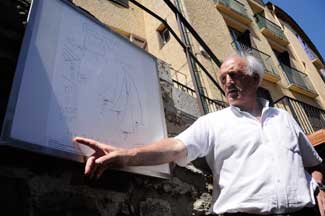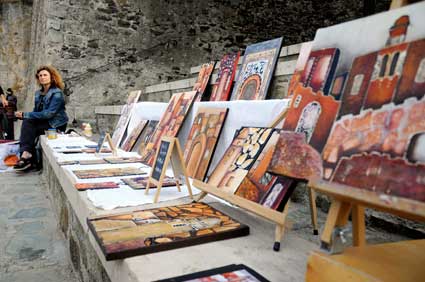Artists Becoming Disillusioned with Collioure
On a bustling street filled with tourists, a man stands alone at drawing table. A tray of heavily used watercolors sits on his right, accompanied by a mason jar half-full of cloudy water. He is using a brush thinner than a pencil, giving a drawing of a Collioure scene its proper color.
Didier Castany has been selling his paintings in Collioure for 12 years now and has lived in the town all of his life. Is this a good place for him, for artists?
“It was,” Castany answers quickly.
Collioure, a town only about 15 miles from the Spanish border and 18 miles from Perpignan, has an art history that goes back to when French artist Henri Matisse started painting in the small town over a century ago. The art scene in Collioure is constantly evolving, with some artists coming to the commune to work simply because of its reputation as an artists’ colony.
But some, like Castany, believe that the art scene in Collioure is changing and that people are coming to Collioure to profit from their art rather than to create it.
“Collioure may be better than a lot of places for artists,” Castany says, “but it’s missing soul.”
***
Barry Blend came to Collioure as a musician 25 years ago, and stayed as an artist. When he first arrived from Britain, he was dedicated to his guitar. Then he began to paint professionally in Collioure.
“He always said, ‘What they do here, with the painting and drawing, I can do as well,’ so I said ‘Well, go ahead,’” says Blend’s wife, Tineke Blend de Grunt. “So he started painting professionally here and he turned out to be a very good artist.”
Like the artists before him, Blend was attracted to the colors of Collioure—the sparkling blue Mediterranean Sea, the lush green mountains. The attraction was so intense that Blend and his wife tried to move several times but always came back.
“The colors are not the way they are in other parts of the country,” Blend de Grunt says. “[Artists] talk about the light, and in the beginning, I thought this was some sort of story, but then every time we came back, we saw it.”

Michel Moly, the mayor of Collioure, agrees. As he discusses how the light is the reason why artists flock to the beachside town, he shifts through his bookcase and pulls out a colorful picture book, Collioure en Méditerranée. He rapidly flips through the glossy pages and finally lands on a photo of Collioure surrounded by the sea, covering two pages.
On the page is a quotation from artist Henri Matisse.
“There isn’t anywhere in France where the sky is bluer than the sky of Collioure,” the bright white type reads, “I just have to open the shutters of my room and I have all of the colors of the Mediterranean at my place.”
Beyond being physically attractive, the city encourages artists to reside in Collioure. Every two years, the town holds a competition where artists come from all over the continent to have their art judged by a panel of four judges, which includes a famous artist that changes each time. The winner of the competition gets a one-year stay in a Collioure apartment and an exhibition of their art.
Moly’s office itself is its own art exhibit. He walks around the room, pointing to each painting and reciting the origin of its painter—“Collioure. Ireland. Scotland.” Like his office, the rest of the rooms in the building house at least one piece of art on the wall, all coming from different places and all representing different styles.
The amount of art in the city hall seems like a lot—that is, until you visit Les Templiers. The three-story restaurant and hotel houses a collection of about 2,000 paintings.
“People come here to drink and to see the museum,” bartender Patrick Palacu says, glancing at the wall opposite to him. It’s covered with paintings, with only a few centimeters here and there of wall space.
Places like this help cement Collioure’s status as a place for artists. Magali Trivino, a painter, lives in nearby Banyuls-sur-Mer, but comes to Collioure to exhibit her work because of its reputation.
She sits by the town’s port next to a line of her paintings, displayed on two steps. A tiny canvas rests in one hand, while she clasps a brown pastry bag used as a paint palette in the other. Trivino discusses the reputation of Collioure with a smile, dropping names like Picasso and Monet, and says that she feels like people actually appreciate her art here.

However, some think the town’s reputation as a haven for artists rests on its history, not its current art scene. Unlike T rivino, Blend de Grunt said she feels like art is becoming more and more commercial in Collioure.
When Blend de Grunt moved to Collioure in 1982, she said that money wasn’t important to many of the artists, but now it has become sort of an industry. This commercialization is partly why Blend de Grunt and her husband are now living in Argelès-sur-Mer.
“We moved out because Collioure is beautiful, but it is becoming an open-air museum,” Blend de Grunt says. “You don’t really want to live in a museum, do you?”
Castany sets up his own personal museum of art under an unusually cloudy sky today. The typically blue sea is a dull gray, the sky sunless. Though he thinks Collioure has lost its spirit, there is one thing that still makes it a special place for artists.
“The light,” he says.
Minutes later, the sun peeks out from behind the clouds. The blue sea glistens once again. The light.
More Stories
Perpignan Lures Tourists with Drama, Culture by Chelsea Boone
Artists Becoming Disillusioned by Collioure by Ariana Bacle
Evangelism in a Catholic Town by Christina Cocca
The Buzz on Declining French Bee Populations by Annie Petersen
Catalans Rediscover Their Culture by Sarah Raghubir
Pétanque Rolls Out of France by Kristin O'Brien
Corrida Brings Controversy to Céret by Victoria King
Pop Goes the Cork Controversy by Marika Washchyshyn
French School Teaches Life Skills by Maegan Simmons
The Fall and Rise of French Blacksmiths by Simon Arseneau
Life in the Abstract by Mary Barczak
The Life Aquatic by Jim Cameron
Police and Fire in Perpignan by Alexis Sanchez
The Colors of Authenticity by Su Kim
French Smokers Hold On To Their Cigarettes by Justine Dhollande
Student Pages
Simon Arseneau
Ariana Bacle
Mary Barczak
Chelsea Boone
Jim Cameron
Christina Cocca
Justine Dhollande
Su Kim
Victoria King
Kristin O'Brien
Annie Petersen
Sarah Raghubir
Alexis Sanchez
Maegan Simmons
Marika Washchyshyn
About the Program
Fifteen college students came from North America to Perpignan, France, in June 2011 to produce these videos and stories. To find out more, read a welcome letter from program director Rachele Kanigel, meet the program faculty and explore the 2010 website.

